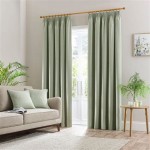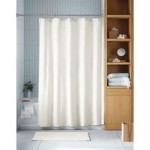What Color Curtains For Living Room: A Comprehensive Guide
Selecting the right curtain color for a living room is a multifaceted decision that impacts the perceived size, atmosphere, and overall aesthetic of the space. Curtains are not merely functional window coverings; they are integral design elements that can either complement or detract from a room's existing features. A considered approach to color selection is crucial, taking into account factors such as wall color, furniture upholstery, flooring, natural light exposure, and desired mood.
This article provides a detailed exploration of various curtain color options for living rooms, offering insights into the considerations that should guide the selection process. It examines the psychological effects of different colors, the interplay between curtain color and other room elements, and practical tips for achieving visual harmony. The aim is to empower the reader to make informed decisions regarding curtain color, ultimately enhancing the comfort and appeal of their living room.
Understanding the Impact of Color Psychology
Color psychology posits that specific colors evoke distinct emotional and psychological responses. Understanding these associations is paramount when selecting curtain colors for a living room, as the chosen hue can significantly influence the mood and ambiance of the space. Several key colors and their associated impacts are detailed below:
Blue: Often associated with tranquility, serenity, and stability, blue curtains can create a calming and relaxing atmosphere in a living room. Lighter shades of blue are particularly effective in promoting relaxation, while darker blues can add a touch of sophistication and formality. However, excessive use of dark blue can make a room feel cold or depressing, especially in spaces with limited natural light.
Green: Representing nature, growth, and harmony, green curtains can bring a sense of freshness and vitality to a living room. They are often associated with balance and rejuvenation, making them a good choice for creating a welcoming and inviting space. Lighter greens tend to be more refreshing and airy, while deeper greens can evoke a sense of richness and sophistication.
Yellow: Symbolizing optimism, happiness, and energy, yellow curtains can inject a cheerful and lively feel into a living room. However, yellow is a powerful color and should be used with caution, as excessive use can be overwhelming or even agitating. Muted or pastel yellows are often a safer bet, providing a touch of warmth without being too intense. These hues are particularly effective in rooms that lack natural light.
Red: Associated with passion, energy, and excitement, red curtains can create a dramatic and stimulating atmosphere in a living room. However, red is a very dominant color and should be used sparingly, as too much red can be overwhelming or even stressful. Deeper shades of red, such as burgundy or maroon, can add a touch of warmth and elegance without being too overpowering. Red curtains are best suited for rooms with a more formal or dramatic design aesthetic.
Orange: Combining the energy of red and the cheerfulness of yellow, orange curtains can create a warm, inviting, and optimistic atmosphere in a living room. Orange is often associated with creativity, enthusiasm, and sociability, making it a good choice for spaces where people gather and interact. However, like red, orange is a powerful color and should be used judiciously. Muted or earthy oranges are often a more palatable option, providing warmth and vibrancy without being too intense.
Purple: Representing royalty, luxury, and creativity, purple curtains can add a touch of elegance and sophistication to a living room. Lighter shades of purple, such as lavender or lilac, can create a calming and serene atmosphere, while darker shades, such as eggplant or plum, can add a touch of drama and opulence. Purple curtains are best suited for rooms with a more formal or eclectic design aesthetic.
Neutral Colors (White, Gray, Beige): These colors offer versatility and adaptability. White curtains create a bright, airy, and clean aesthetic. Gray curtains provide a sophisticated and contemporary feel. Beige curtains offer warmth and neutrality, blending seamlessly with various design styles. Neutral colors are generally safe choices, easily incorporated into existing color schemes, and serve as a backdrop for other bolder elements within the room.
Considering the Interplay with Existing Room Elements
Selecting curtain colors in isolation is not advisable. The chosen hue should harmonize with the existing elements of the living room, including wall color, furniture upholstery, flooring, and accessories. A cohesive and balanced color scheme is essential for creating a visually appealing and harmonious space. Several considerations are detailed below:
Wall Color: The color of the walls is a dominant factor that significantly influences the selection of curtain colors. For walls painted in neutral colors, such as white, gray, or beige, there is greater flexibility in choosing curtain colors. Bold or patterned curtains can be used to add visual interest and personality to the room, while neutral curtains can create a more subtle and understated look. For walls painted in vibrant or saturated colors, it is often best to opt for curtains in complementary or analogous colors. Complementary colors are those that are opposite each other on the color wheel, such as blue and orange, or red and green. Analogous colors are those that are adjacent to each other on the color wheel, such as blue and green, or yellow and orange.
Furniture Upholstery: The color and pattern of the furniture upholstery should also be taken into consideration when selecting curtain colors. If the furniture is upholstered in a solid color, the curtains can be used to introduce pattern or texture to the room. Conversely, if the furniture is upholstered in a bold pattern, it is often best to opt for curtains in a solid color that complements one of the colors in the pattern. It is important to ensure that the curtain color does not clash with the upholstery color but rather creates a sense of visual harmony.
Flooring: The color and material of the flooring can also influence the selection of curtain colors. For light-colored flooring, such as light wood or white tile, darker curtains can provide a grounding effect and add depth to the room. For dark-colored flooring, such as dark wood or dark carpet, lighter curtains can help to lighten up the space and create a more airy feel. The material of the flooring, such as wood, tile, or carpet, can also influence the texture and weight of the curtains that are chosen.
Accessories: The colors of the accessories in the living room, such as rugs, pillows, artwork, and decorative objects, should also be taken into consideration when selecting curtain colors. The curtains can be used to tie together the various colors and patterns in the room, creating a cohesive and harmonious look. It is often helpful to choose a curtain color that picks up on one of the dominant colors in the accessories, or to choose a neutral curtain color that allows the accessories to stand out.
Natural Light: The amount of natural light that a living room receives is a crucial factor in determining the appropriate curtain color. Rooms with ample natural light can accommodate darker and more saturated colors without feeling oppressive. Conversely, rooms with limited natural light benefit from lighter, brighter curtains that reflect light and create a more airy feel. The direction that the windows face also affects the type of light that enters the room. South-facing windows receive warm, direct sunlight, while north-facing windows receive cool, indirect light. Curtains should be chosen accordingly to balance the light and create a comfortable atmosphere.
Practical Tips for Achieving Visual Harmony
Achieving visual harmony in a living room involves careful consideration of color, texture, and pattern. The following practical tips can assist in creating a balanced and aesthetically pleasing space through the strategic selection of curtain colors:
Utilize a Color Palette: Before selecting curtain colors, establish a clear color palette for the living room. This palette should include a dominant color, secondary colors, and accent colors. The curtains should complement the existing color palette, either by blending in seamlessly with the dominant color or by providing a contrasting accent color. A color wheel can be a helpful tool in selecting colors that are harmonious and visually appealing.
Consider the Scale of the Room: The size of the living room should be taken into consideration when selecting curtain colors. In smaller living rooms, lighter colors can help to create a sense of spaciousness and airiness. Darker colors can make a small room feel even smaller and more cramped. In larger living rooms, darker colors can be used to create a more intimate and cozy atmosphere. However, it is important to balance darker colors with lighter colors to prevent the room from feeling too heavy or oppressive.
Incorporate Texture and Pattern: Texture and pattern can add depth and visual interest to a living room. Curtains with texture, such as linen or velvet, can add a sense of tactility and warmth to the space. Patterned curtains can add personality and visual interest, but it is important to choose patterns that are in scale with the size of the room and that complement the existing color palette. Avoid overwhelming the space with too many patterns; if using patterned curtains, keep other elements relatively simple and neutral.
Test Samples Before Committing: Before purchasing curtains, it is essential to test samples of the colors and fabrics in the living room. The appearance of colors can vary depending on the lighting conditions and the surrounding colors. Hold the samples up against the walls, furniture, and flooring to see how they look in the space. Observe the samples at different times of day to see how the colors change with the varying light conditions. This step can prevent costly mistakes and ensure that the chosen curtains are a good fit for the living room.
Consider the Functionality of the Curtains: In addition to aesthetics, the functionality of the curtains should also be considered. If privacy is a concern, opt for curtains that are opaque or that have a blackout lining. If light control is desired, choose curtains that are adjustable, such as shades or blinds. If energy efficiency is a priority, choose curtains that are insulated or that have a thermal lining. The functionality of the curtains should be balanced with the aesthetic considerations to create a space that is both beautiful and practical.
Seek Professional Advice: If uncertain about selecting the right curtain colors for a living room, consider seeking professional advice from an interior designer. An interior designer can provide expert guidance on color selection, fabric selection, and overall design coordination. They can assess the existing elements of the room, understand the desired mood and functionality, and recommend curtain colors that will enhance the space and achieve the desired aesthetic. While there is an associated cost, the investment can result in a significantly more polished and cohesive living room.

Inspired Curtain Colour Combinations For Your Living Room Homelane Blog

20 Attractive Living Room Curtains Small Layout

15 Best Living Room Curtain Ideas Window Treatments

Curtains For White Walls Living Room In 2024
:strip_icc()/img39o-e6af5ad60b0341188fbb6113e3653ceb.jpg?strip=all)
22 Living Room Curtain Ideas For Your Home

Best Curtain Colours For Diffe Types Of Walls Housing News

Yellow Gray And Green Color Block Drapery Homedecor Windowtreatment Livingroomcurtain Living Room Draperies Curtains Elegant

How To Pick Living Room Curtains That Perfectly Match Your Style

Curtain Color Combination For Your Home Designcafe

8 Modern Curtain Designs For Living Room Designcafe








